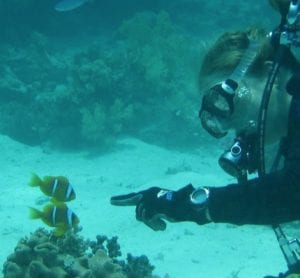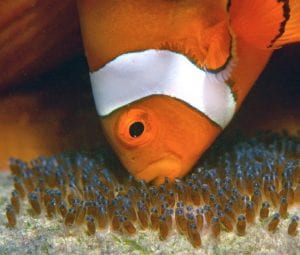Anemonefish parental care diversity project
Citizen science request for videos from the reef aquarium and diving communities
Our Project
We are interested in the relative time spent by male vs female anemonefishes (also known as clownfish) in parental care of eggs. We know, from a couple species of anemonefishes studied so far, that they have both male and female care, and that the male spends more time caring for the eggs.
It is unknown whether this division of parent care labor varies among species of anemonefishes, but that variation can give us clues about how sex roles in parental care evolve.
You can help us learn about the evolution of parental care by submitting videos of your anemonefish caring for their eggs. Also – if you are a diver and able to record video underwater, we would be very excited to have video contributions showing wild anemonefishes caring for eggs too!
Who is the main contact?
Please contact Dr. Kavanagh at kkavanagh@umassd.edu for any questions.
How can you help?
You can send us 15-30 minute videos of your anemonefish (any species) tending eggs on specific days! We want videos of anemonefish parents tending eggs on Day 1, Day 4, and Day 7. If you don’t know when the eggs were laid, just take a photo of the eggs fairly close and we will be able to tell how old they are.
If you can’t take a 30 minute video, then a series of shorter videos from the same day (e.g. Day 1 after spawning) would be fine.
One more request: Please also take a photo or video with a scale of some sort (even if you tell us the width of something in the aquarium close to the fish as a calibration), so we can determine the sizes of the fish.
We will be happy to accept as much video as you can provide from any clownfish or anemonefish species, genus Amphiprion or Premnas, regardless of tank quality or community members, as long as you can see the fish!
How to submit your video.
When you are ready to submit your video, contact us by email and we’ll send you a link to access our video repository. You can contact Dr. Kavanagh at kkavanagh@umassd.edu
We expect we will be accepting videos until March 2023. This date may be extended: Check kkavanagh.sites.umassd.edu/citizen-science for any updates.
*****************************************************
F.A.Q.
What should I name the video files?
File names: should include your name, species name*, age of the eggs, date and time of the filming
Example: Kavanagh_A-ocellaris-pairA_day4_29Oct20_1400
If you have multiple breeding pairs of the same species, indicate which pair by labeling them A and B, etc.
*If you are unsure of what species of clownfish you own, please use the identifier Unknown-A, Unknown-B, etc, instead of the species name. We will be able to identify it from a photo! Example: Pitman_Unknown-A_day4_29Oct20_1400
How long should the video be?
Ideally: 30 minute videos. 30 minutes is the minimum needed to get a reliable sample of parental care behavior for comparisons.
If you can’t take a 30 minute video, then a series of shorter videos from the same day (e.g. Day 1 after spawning) would be fine.
What age should the eggs be? What if I don’t know when the eggs were laid?
To test whether there are changes in behavior as the eggs get older, we would like videos from Day 1, Day 4, and Day 7 after laying. If you are unsure of the age of the eggs, don’t worry, just include a photo of the eggs, and we can probably tell how old they are.
How far away should the camera be? Do you have tips for filming?
Here are a few tips:
Set up the camera with a stand or tripod to improve stability.
We will be looking for tending behaviors, so film from a position where both male and female can be observed near the egg clutch. The ideal distance is roughly 3 feet from the tank. (Underwater scenarios may be different but generally a broad view near the anemone and the egg mass.)
Please try to limit the amount of disturbance to the breeding pair while recording.
The file size is HUGE. Can I reduce this somehow?
There are a couple things you can do. If there is a high quality or HD option on your camera, please use the lower quality or non-HD quality to minimize file size.
Feel free to compress the file if you have the capability. Email to discuss if you are unsure and we’ll help you with your specific situation.
Can I submit video from the wild? From my diving trip to a reef?
100% yes. That would be great. Just focus on the anemonefish guarding eggs and try to get the parents in view! We still need ~30 minutes. If it’s not obvious there are eggs in the recording because the anemone is covering them, take a photo afterwards of the eggs up close if possible. That will also help us age the eggs. Also, please include the location of the fish (longitude/latitude of the dive, if you have it).
Can my friend get involved?
Yes, please forward this link to anyone interested, especially anyone who has breeding anemonefish, or is an underwater reef photographer! Thanks!
What will we do with the videos?
The videos will be scored for the amount of time that the male or female parent spends tending the eggs. We will score specific behaviors like mouthing or cleaning the eggs, fanning, defensive or aggressive behaviors in the subset of videos that allow us to see those details. The data will be analyzed to see if parental care changes over the course of egg development, if parental care is consistent within species, whether related anemonefishes have similar sex roles established, and whether older individuals are more or less involved in parental care. We might also be able to examine whether behaviors are similar in the wild vs in captivity.
We will post the results of our research on this website when we get them and all contributors will be acknowledged. Thank you for your interest!

